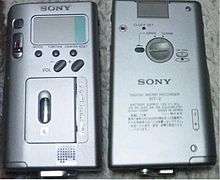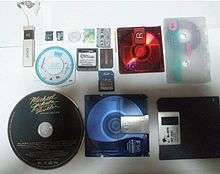NT (cassette)



NT is a digital memo recording system introduced by Sony in 1992, sometimes marketed under the name Scoopman. The system stored memos using helical scanning on special microcassettes, which were 30 × 21.5 × 5 mm with a tape width of 2.5 mm, with a recording capacity of up to 120 minutes. The Scoopmen cassettes are offered in three versions: The Sony NTC-60, -90, and -120, each describing the length of time (in minutes) the cassette can record.
NT stands for Non-Tracking, meaning the head does not precisely follow the tracks on the tape. Instead, the head moves over the tape at approximately the correct angle and speed, but performs more than one pass over each track. The data in each track is stored on the tape in blocks with addressing information that enables reconstruction in memory from several passes. This considerably reduced the required mechanical precision, reducing the complexity, size, and cost of the recorder.
Another feature of NT cassettes is Non-Loading, which means instead of having a mechanism to pull the tape out of the cassette and wrap it around the drum, the drum is pushed inside the cassette to achieve the same effect. This also significantly reduces the complexity, size, and cost of the mechanism.
Audio sampling is in stereo at 32 kHz with 12 bit nonlinear quantization, corresponding to 17 bit linear quantization. Data written to the tape is packed into data blocks and encoded with LDM-2 low deviation modulation.[1]
The Sony NT-2 Digital Micro Recorder, introduced in 1996 and shown here, features a real-time clock that records a time signal on the digital track along with the sound data, making it useful for journalism, police and legal work.[2] Due to the machine's buffer memory, it is capable of automatically reversing the tape direction at the end of the reel without an interruption in the sound.[2] The recorder uses a single "AA"-size cell for primary power, plus a separate CR-1220 lithium cell to provide continuous power to the real-time clock.[2] The Sony NT-2, an improved successor to the Sony NT-1 Digital Micro Recorder, introduced in 1992, was the final machine in the series. The NT cassette systems cost more than a DAT recorder in their day, are fragile and relatively unreliable compared to other emerging recording technologies, and being unable to compete soon disappeared from the market.[3] The devices are considered curiosities for collectors.
See also
References
- ↑ Himeno, Takuji. "High-density magnetic tape recording by a nontracking method". Electronics and Communications in Japan (Part II: Electronics). 76: 83–93. doi:10.1002/ecjb.4420760510.
- 1 2 3 The World's Smallest Cassette Tape on YouTube
- ↑ http://www.praktiker.at/download/lepau604.pdf Review of Sony NT-1 Scoopman and technical data (in German)